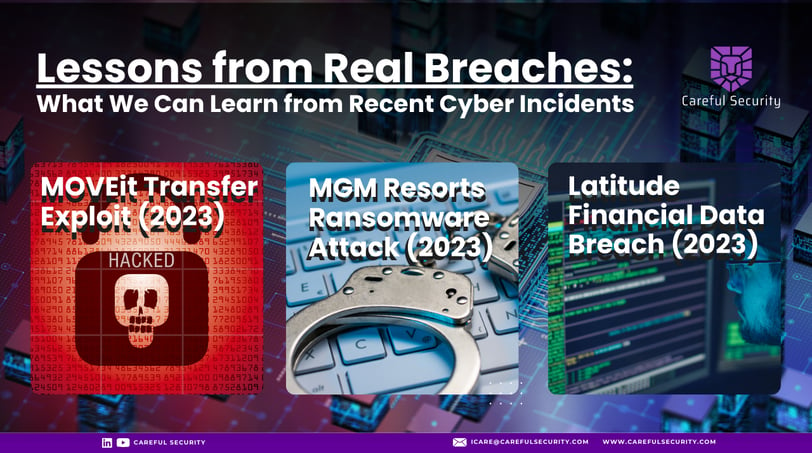Lessons from Real Breaches
What We Can Learn from Recent Cyber Incidents


Cyber attacks are no longer rare events that only affect massive corporations. In recent years, breaches have become more frequent, more sophisticated, and more damaging. From multinational companies to healthcare providers and even small businesses, no organization is immune. For cyber security professionals and business leaders alike, it’s critical to understand what went wrong in these breaches and more importantly, how to prevent similar incidents.
In this blog post, we’ll break down some of the most significant recent cyber incidents, identify common patterns, and extract actionable lessons that can help any organization strengthen its defenses.
The Reality: Breaches Are Everywhere
Let’s start with an uncomfortable truth: cyber security threats are omnipresent. Whether it's ransomware attacks, phishing campaigns, or supply chain vulnerabilities, attackers constantly evolve their tactics to exploit weaknesses. The 2023 IBM Cost of a Data Breach Report revealed that the average cost of a data breach reached $4.45 million—a record high.
Yet beyond the financial damage, breaches erode trust, damage reputations, and often lead to legal consequences. That’s why learning from real-world examples is essential.
Case Study #1: MOVEit Transfer Exploit (2023)
One of the most notable incidents in 2023 involved the exploitation of the MOVEit Transfer file-sharing software, used by numerous organizations for secure data exchange. A vulnerability in the software allowed attackers to access sensitive data, affecting financial institutions, government agencies, and healthcare providers.
Lesson Learned:
Third-party software is a major risk vector. It’s critical to conduct thorough vendor risk assessments and monitor security advisories for software dependencies. Organizations should also apply patches promptly and use tools that detect anomalous behavior in file-sharing systems.
Actionable Takeaway:
Implement a Software Bill of Materials (SBOM) and set up a Vendor Risk Management Program to ensure your team is aware of what third-party services you rely on and how secure they are.
Case Study #2: MGM Resorts Ransomware Attack (2023)
MGM Resorts, one of the largest casino and hotel operators in the world, fell victim to a ransomware attack in 2023. Attackers used social engineering to manipulate IT help desk staff, gaining access to internal systems. The breach led to service outages, financial losses, and reputational damage.
Lesson Learned:
Humans are often the weakest link. Despite technological safeguards, attackers often use simple manipulation tactics to bypass defenses.
Actionable Takeaway:
Strengthen employee awareness with cyber security training that includes social engineering simulations. Ensure IT and customer service teams follow strict identity verification procedures.
Case Study #3: Latitude Financial Data Breach (2023)
Australian financial services provider Latitude Financial disclosed a breach where the personal data of over 14 million individuals was compromised. The breach occurred due to compromised employee credentials, and attackers maintained access for an extended period.
Lesson Learned:
Credential security and detection speed matter. Once attackers are inside your network, time is of the essence. Extended dwell time increases the damage significantly.
Actionable Takeaway:
Adopt Multi-Factor Authentication (MFA) across all systems, and invest in endpoint detection and response (EDR) tools to identify threats early.
Key Takeaways from Recent Incidents
Now that we’ve looked at specific cases, let’s explore the recurring themes and what organizations of any size can do to mitigate similar risks.
1. Patch Management Cannot Be Delayed
A significant portion of recent breaches were caused by known vulnerabilities that had not been patched. This includes both proprietary systems and third-party applications.
What You Can Do:
Create a robust patch management policy that includes a prioritization framework. Critical vulnerabilities should be addressed within 24 to 48 hours of disclosure. Automation tools can help streamline this process.
2. Zero Trust Architecture Is Not Optional
Gone are the days when a strong perimeter defense was enough. With remote work, cloud adoption, and increased insider threats, adopting a Zero Trust approach is essential.
What You Can Do:
Implement least privilege access, continuously verify user identities, and segment networks to prevent lateral movement in case of a breach.
3. Incident Response Plans Must Be Tested
Many companies have incident response plans on paper—but when the alarm goes off, they falter due to lack of practice.
What You Can Do:
Conduct regular tabletop exercises and red team drills to ensure your teams know their roles and can respond efficiently. Having a plan is good; knowing it works is better.
4. Employee Training Is Your First Line of Defense
No matter how advanced your cyber security tools are, if your employees can’t recognize phishing emails or understand safe data practices, you’re vulnerable.
What You Can Do:
Launch a cyber security awareness program with periodic training, simulated phishing tests, and clear communication channels for reporting suspicious activity.
5. Invest in Continuous Monitoring and Detection
Breaches often go undetected for weeks or months. During that time, attackers can exfiltrate data, deploy malware, or compromise more systems.
What You Can Do:
Use Security Information and Event Management (SIEM) systems combined with machine learning to monitor for unusual activity across your network. Integrate these tools with your incident response workflows.
6. Legal and Regulatory Readiness Is Crucial
Many organizations face hefty fines not just for the breach itself but for failing to report it properly or lacking sufficient protections under regulatory requirements like GDPR, HIPAA, or CCPA.
What You Can Do:
Ensure your data protection practices align with the applicable laws in your industry and jurisdiction. Maintain clear documentation, audit trails, and reporting capabilities.
Final Thoughts: Be Proactive, Not Reactive
Cyber security is no longer just an IT issue it’s a business imperative. As we’ve seen, even well-known companies with substantial resources have suffered major breaches due to relatively simple oversights.
The good news is that many of these incidents offer us a blueprint. By studying these real-world cases, we can identify gaps in our own systems and take proactive steps to close them.
Cyber threats will continue to evolve. So must our defenses.
Your All-in-One Cybersecurity Partner
© 2025. All rights reserved.
